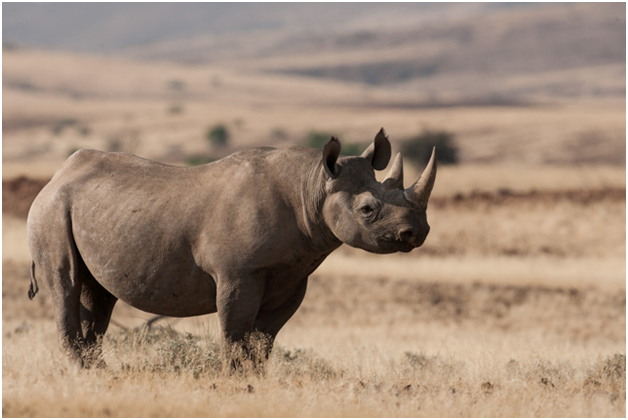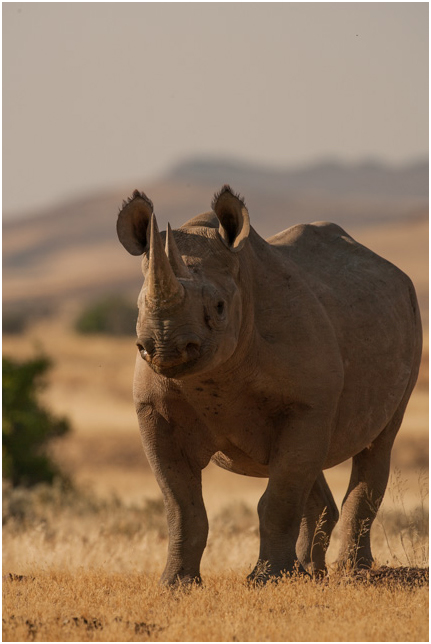Conservation efforts bring cautious hope for African rhinos - IUCN Red List
Gland, Switzerland, 19 March 2020 (IUCN) – The African Black Rhino remains Critically Endangered, but its population is slowly increasing as conservation efforts counter the persistent threat of poaching, according to today’s update of the IUCN Red List of Threatened SpeciesTM.
Between 2012 and 2018, the Black Rhino (Diceros bicornis) population across Africa has grown at a modest annual rate of 2.5% from an estimated 4,845 to 5,630 animals in the wild, respectively. Population models predict a further slow increase over the next five years, according to today’s update.
The IUCN Red List now includes 116,177 species of which 31,030 are threatened with extinction.
"While Africa’s rhinos are by no means safe from extinction, the continued slow recovery of Black Rhino populations is a testament to the immense efforts made in the countries the species occurs in, and a powerful reminder to the global community that conservation works. At the same time, it is evident that there is no room for complacency as poaching and illegal trade remain acute threats," said Dr Grethel Aguilar, Acting Director General of IUCN. “It is essential that the ongoing anti-poaching measures and intensive, proactive population management continue, with support from national and international actors."
“These developments for African rhinos show the changes that can be achieved through committed conservation action,” said Dr Jane Smart, Global Director of the IUCN Biodiversity Conservation Group. “It is crucial that local people are increasingly involved in and benefit from conservation efforts. International, national and local actors need to work together to tackle the biodiversity crisis. It will be criticial for the voices of those working in the field to protect threatened species such as African Rhinos to be amplified in coming years as we set the conservation agenda for the next decade.”
The increase in Black Rhino numbers is mainly due to continuing law enforcement efforts and successful population management measures, including moving selected rhinos from established populations to new locations to keep populations productive and increase the species’ range. One subspecies of the Black Rhino, the South-western Black Rhino (D. b. bicornis) – previously assessed as Vulnerable – has seen sufficient population growth over the last three generations to be newly categorised as Near Threatened. The other two surviving subspecies, the South-eastern (D. b. minor) and Eastern (D. b. michaeli), both remain Critically Endangered following heavy declines between the 1970s and mid-1990s. While all three surviving subspecies are on a slow path of recovery, they remain dependent on continued conservation efforts.
Africa’s other rhino species, the more numerous White Rhino (Ceratotherium simum) continues to be categorised as Near Threatened on the IUCN Red List. Numbers of the Southern White Rhino (C. s. simum) subspecies declined by 15% between 2012 and 2017 from an estimated 21,300 to 18,000 animals, which largely cancelled out most of the growth in White Rhino numbers from 2007 to 2012. This recent decline was largely due to the high levels of poaching in South Africa's Kruger National Park, home to the world’s largest White Rhino population. The other White Rhino subspecies, the Northern White Rhino (C. s. cottoni), remains Critically Endangered (Possibly Extinct in the Wild). The White Rhino is more vulnerable to poaching as it has larger horns, and favours more open habitats so is easier to find than the black rhino.
The poaching of African rhinos to supply the illegal international rhino horn trade remains the main threat to the two species. However, the strong counter-measures taken by range states, private landowners and communities in recent years are having a positive effect: recorded poaching of African rhinos has been declining at a continental level in recent years. After a peak in 2015, when a minimum of 1,349 rhinos were found to have been poached – an average of 3.7 rhinos poached per day – poaching numbers have decreased every year since. In 2018, there were a minimum of 892 rhinos poached – approximately 2.4 African rhinos poached every day, or one every ten hours. Preliminary data for 2019 indicates poaching levels have further declined.
“With the involvement of transnational organised crime in poaching, rhino crimes are not just wildlife crimes. A number of range States are to be commended for their efforts, elevating rhino crimes to a higher level and taking a more ‘whole of government’ approach to combat the organised crime behind the poaching. If the encouraging declines in poaching can continue, this should positively impact rhino numbers. Continued expenditure and efforts will be necessary to maintain this trend,” said Dr Richard Emslie, Red List Authority Coordinator for the IUCN Species Survival Commission’s African Rhino Specialist Group.
While conservation efforts have led to slightly lower levels of rhino poaching in recent years, the costs of keeping rhinos safe have risen greatly and live sale prices have significantly decreased over the last decade, reducing incentives for private landowners and communities to keep rhinos. With around half of White Rhinos and close to 40% of Black Rhinos now conserved on privately or community managed land, the trend towards rhinos being increasingly viewed as costly liabilities could threaten to limit or reverse the future expansion of the species’ range and numbers.
Supporting quotes:
“We are pleased to have supported 65% of the species assessments in this IUCN Red List update,” said Masako Yamato, General Manager, Environmental Affairs Division of Toyota Motor Corporation. “This up-to-date information will be highly valuable to all of society for informing conservation commitments as part of the Post 2020 Biodiversity Framework.”
Quotes from Red List Partners
“Even though black rhinos remain at high risk, it’s encouraging to see that their population has started to regrow,” said Dr. M. Sanjayan, CEO of Conservation International. “Now, we must double down on the critical conservation work that governments and local communities have undertaken in recent years. Together, we can stop the tragedy of wildlife poaching and bring black rhinos back from the brink of extinction.”
“Protecting the planet's precious biodiversity has never been more important. Every day, the obstacles to saving native species from extinction and preserving ecosystems are growing,” said Sean T. O’Brien, President and CEO of Nature Serve. O’Brien continued, “We must seek out opportunities to bring together data, science, and technology to help solve one of the scariest environmental challenges of our time, the mass extinction of untold numbers of species."
“The Missouri Botanical Garden is delighted to join the IUCN Red List Partnership, which provides an unparalleled opportunity to link our diverse conservation activities to this globally important initiative and to collaborate with other partners by conducting conservation assessments and participating in coordinated conservation actions focused specifically on endangered plants,” said Pete Lowry, Director, Africa & Madagascar Program, Missouri Botanical Garden.
“The recent Red List assessment of the status of rhinos reveals the degree to which we have had to isolate them in order to conserve them. Movement is restricted to increasingly smaller enclaves, often under near militarized conditions. We intensively manage all aspects of their biology. In our efforts to recover populations, we are still far from restoring rhinos and other species without social fragmentation. Ranging free and wide on restored entire landscapes must be our goal,” said Dr. Thomas E. Lacher, Jr., Professor, Ecology and Conservation Biology, Texas A&M University.
“A key lesson of the gradually improving status of African rhinos is that conservation works. We know what needs to be done, and must expand conservation action worldwide to continue to reverse the decline to these and other threatened species,” said Dr Jon Paul Rodríguez, Chair, IUCN Species Survival Commission.
"Thanks to the immense efforts and investment made into the protection of black rhino we are now witnessing populations recover. This is a great achievement, given the scale of the challenge. However, populations remain at a fraction of their historical level. We need to continue to promote wholesale recovery across their range. This is going to require innovative approaches to growing numbers, managing habitat and engaging stakeholders. Tools such as the Rhino Impact Bond were designed to facilitate just this sort of growth," said Dr Andrew Terry, Director of Conservation & Policy, ZSL.
Download photos and summary statistics here.
For more information or interviews please contact:
Harriet Brooker, IUCN Media Relations, +44 7960 241862, harriet.brooker@iucn.org
Matthias Fiechter, IUCN Media Relations, +41 79 536 0117, matthias.fiechter@iucn.org
Notes to editors
The IUCN Red List: The IUCN Red List of Threatened Species™ contributes to the achievement of Target 12 of the 2011 to 2020 Strategic Plan for Biodiversity. Target 12: By 2020 the extinction of known threatened species has been prevented and their conservation status, particularly of those most in decline, has been improved and sustained.
IUCN–Toyota Partnership: The five-year partnership between IUCN and Toyota Motor Corporation announced in May 2016 has been significantly increasing knowledge on the extinction risk of more than 28,000 species, including many that are key food sources for a significant portion of the global population. This partnership is driven by the Toyota Environmental Challenge 2050, which aims to reduce the negative impacts associated with automobiles to zero, whilst simultaneously making positive impacts on society.
The IUCN Red List
Global figures for the 2020-1 IUCN Red List of Threatened Species:
- TOTAL SPECIES ASSESSED = 116,177
- (Total threatened species = 31,030)
- Extinct = 878
- Extinct in the Wild = 75
- Critically Endangered = 6,523
- Endangered = 11,067
- Vulnerable = 13,440
- Near Threatened = 6,976
- Lower Risk/conservation dependent = 190 (this is an old category that is gradually being phased out of The IUCN Red List)
- Least Concern = 59,874
- Data Deficient = 17,154
The figures presented above are only for those species that have been assessed for The IUCN Red List to date. Although not all of the world’s species have been assessed, The IUCN Red List provides a useful snapshot of what is happening to species today and highlights the urgent need for conservation action. Relative percentages for threatened species cannot be provided for many taxonomic groups on The IUCN Red List because they have not been comprehensively assessed. For many of these groups, assessment efforts have focused on threatened species; therefore, the percentage of threatened species for these groups would be heavily biased.
For those groups that have been comprehensively assessed, the percentage of threatened species can be calculated, but the actual number of threatened species is often uncertain because it is not known whether Data Deficient (DD) species are actually threatened or not. Therefore, the percentages presented above provide the best estimate of extinction risk for those groups that have been comprehensively assessed (excluding Extinct species), based on the assumption that Data Deficient species are equally threatened as data sufficient species. In other words, this is a mid-point figure within a range from x% threatened species (if all DD species are not threatened) to y% threatened species (if all DD species are threatened). Available evidence indicates that this is a best estimate.
The IUCN Red List threat categories are as follows, in descending order of threat:
Extinct or Extinct in the Wild
Critically Endangered, Endangered and Vulnerable: species threatened with global extinction.
Near Threatened: species close to the threatened thresholds or that would be threatened without ongoing conservation measures.
Least Concern: species evaluated with a lower risk of extinction.
Data Deficient: no assessment because of insufficient data.
Critically Endangered (Possibly Extinct): this is not a new IUCN Red List Category, but is a flag developed to identify those Critically Endangered species that are in all probability already extinct but for which confirmation is required; for example, through more extensive surveys being carried out and failing to find any individuals





